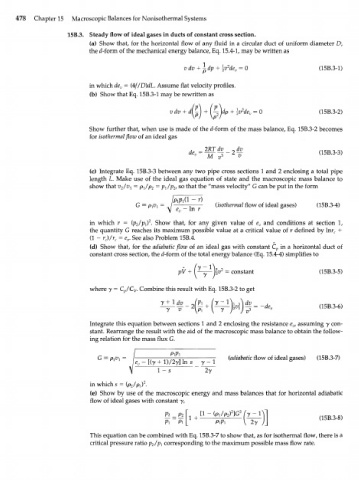Page 498 - Bird R.B. Transport phenomena
P. 498
478 Chapter 15 Macroscopic Balances for Nonisothermal Systems
15B.3. Steady flow of ideal gases in ducts of constant cross section.
(a) Show that, for the horizontal flow of any fluid in a circular duct of uniform diameter D,
the rf-form of the mechanical energy balance, Eq. 15.4-1, may be written as
vdv + ^dp + \v4e v = О (15В.З-1)
in which de v = (4f/D)dL Assume flat velocity profiles.
(b) Show that Eq. 15B.3-1 may be rewritten as
v dv + d( ^ ) + [ — )dp + \v4e v = О (15В.З-2)
v / \p /
Show further that, when use is made of the d-form of the mass balance, Eq. 15B.3-2 becomes
for isothermal flow of an ideal gas
, 2RT dv ~ dv ,- „ о оч
~W^~ ^ (15B.3-3)
d6v = 2
(c) Integrate Eq. 15B.3-3 between any two pipe cross sections 1 and 2 enclosing a total pipe
length L. Make use of the ideal gas equation of state and the macroscopic mass balance to
show that v /v- ~ р /р 2 = Р\1ръ so that the "mass velocity" G can be put in the form
л
[
1
/PiPid - r)
G = p v = —: {isothermal flow of ideal gases) (15B.3-4)
x x
2
in which r = ip /p\) . Show that, for any given value of e and conditions at section 1,
2 v
the quantity G reaches its maximum possible value at a critical value of r defined by lnr +
c
(1 - r )/r c = e . See also Problem 15B.4.
v
c
(d) Show that, for the adiabatic flow of an ideal gas with constant C in a horizontal duct of
p
constant cross section, the d-iorm of the total energy balance (Eq. 15.4-4) simplifies to
pV + ^ - у Ч ^ 2 = constant (15B.3-5)
(
where у = C /C . Combine this result with Eq. 15B.3-2 to get
p v
2 + = d6v (15B3 6)
( ^ - r ) 7 ~ "
Integrate this equation between sections 1 and 2 enclosing the resistance e assuming у con-
vf
stant. Rearrange the result with the aid of the macroscopic mass balance to obtain the follow-
ing relation for the mass flux G.
/ PiPi
G = p№ = / —, . . . (adiabatic flow of ideal gases) (15B.3-7)
&
e - [(y + l)/2y]ln s y- I
1 W
v
\ f^s 2y
in which s = (p /'P\) . 2
2
(e) Show by use of the macroscopic energy and mass balances that for horizontal adiabatic
flow of ideal gases with constant y,
( l 5 B 3 8 )
-
This equation can be combined with Eq. 15B.3-7 to show that, as for isothermal flow, there is a
critical pressure ratio p /p\ corresponding to the maximum possible mass flow rate.
2

